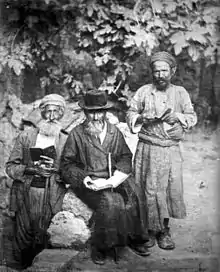Meshulach
A meshulach (Hebrew: משולח) (plural: meshulachim) or SHaDaR (שד"ר, acronym for SHelichei DeRabonan - an emissary of the rabbis; according to others, the acronym is SHelichah DeRachmanah - an emissary from God) is a rabbinical emissary sent to collect charity funds (Halukka). In the original meaning it was for the rescue of the Yishuv haYashan of Eretz Yisrael, the funds were distributed by the Kollelim in form of Halukka.
| Old Yishuv |
|---|
 |
| Key events |
| Key figures |
|
| Economy |
| Philanthropy |
| Communities |
| Synagogues |
| Related articles |
In recent times, the term has come to mean any charity collector for a Jewish organization. Often an individual meshulach may operate as an independent contractor for several different organizations, taking a portion of the proceeds as profit. The percentage retained by the meshulach is sometimes as high as 49%.
In response to the public perception of fraudulent meshulachim, some communities (for example, Baltimore) have appointed rabbis or panels to investigate meshulachim and issue them certificates to attest for the validity of their cause.
Originally only trustworthy meshulachim were employed. A list of the best-known meshulachim, with their dates and spheres of activity, is provided here:
- 1441. Esrim ve-Arba‘ah: Europe.
- 1587. Joseph ben Moses Miṭrani the Elder (or di Ṭrani, 1569–1639): Egypt.
- 1598–1599. Joseph ben Moses Miṭrani the Elder (or di Ṭrani, 1569–1639): Istanbul (first mission).
- 1600. Judah de Leon: Italy.[1]
- 1600s–1606. Joseph ben Moses Miṭrani the Elder (or di Ṭrani, 1569–1639): Istanbul (second mission).
- 1650. Nathan ben Reuben David Spiro: Italy and Germany.[2]
- 1659. Benjamin ha-Levi: the Levant and Italy.[3]
- 1670s. Judah Sharaf: Livorno, Italy.
- 1676. Joseph ben Eliezer: Italy and Germany.
- 1676. Joseph Shalit Riqueti: Italy and Germany (with the preceding, author of Iggeret Mesapperet).
- 1688–1692. Ḥezekiah ben David da Silva (1656–1697): Western Europe (including Amsterdam).
- 1690. Judah Sharaf: the Levant and Italy.[4]
- 1695. Avraham Yitzchaḳi: Italy.[5]
- 1695. Shmuel ha-Kohen: Italy, etc.[6]
- 1695. Abraham ben Levi Conque: Italy, Germany, and Poland.[7]
- 1700. Hayyim Asael ben Benjamin: Smyrna.[8]
- 1705. Gedaliah Hayyim: Italy.[9]
- 1709. Nathan Mannheim: Germany and Poland.
- 1709. Jacob of Vilna: Germany and Poland (with the preceding, author of Me’orot Natan).
- 1710. David Melammed.
- 1712. Hayyim Hazzan.[10]
- 1712. Abraham Rovigo.[11]
- 1718. Hayyim Jacob ben Jacob David: the Levant and Europe.[12]
- 1720. Ephraim ben Aaron Nabon: Italy.[13]
- 1730. David Capsoto: Holland.[14]
- 1730. Moses Hagiz: the Levant and Europe for a period of 50 years (Azulai, Shem ha-Gedolim, i. 34).
- 1740. Baruch Gad: Media and Persia (Nepi-Ghirondi, l.c. p. 58).
- 1740s–1749. Ḥayyim ben Elias Moda‘i.
- 1750. Baruch of Austria (ib. p. 62).
- 1750. Hayyim Joseph David Azulai (1724–1806): the Levant and Europe (including Egypt, Amsterdam, England, and Livorno, for 56 years. His Ma‘agal Yashar contains part of his itinerary).
- 1750. Hayyim Abraham Tzebi: Italy (ib. p. 115).
- 1750. Hayyim Mordecai Tzebi: Italy, etc. (Michael, l.c. No. 886).
- 1750. Rahmim Nissim Mizrahi: the Levant and Italy (Nepi-Ghirondi, l.c. p. 312).
- 1759. Moses Malki: America (Publications of the American Jewish Historical Society p. 18).
- 1760. Hayyim Nissim Jeroham of Vilna: Germany (Qiryah Ne’emanah, p. 114, together with other meshullahim).
- 1760. Yom-Ṭob al-Ghazi: the Levant and Italy (Nepi-Ghirondi, l.c. p. 167).
- 1760s. Ḥayyim ben Elias Moda‘i (1720–1794): Holland (wrote approbation to Pe’er ha-Dor) and elsewhere in Europe.
- 1765. Jacob al-Yashar: Persia.
- 1767. Issachar Abulafia: Italy (wrote approbation to Yad Mal’akhi).
- 1770. Abraham Solomon Zalmon: Europe (Nepi-Ghirondi, l.c. p. 61).
- 1772. Abraham Segre: Germany (Nepi-Ghirondi, l.c. p. 25).
- 1773. Raphael Chayyim Isaac Carregal: West Indies and the British Colonies of North America.
- 1776. Jacob Raphael Saraval: Holland and England (ib. p. 206).
- 1780. Judah Samuel Ashkenazi (ib. p. 214).
- 1783. Abraham ha-Kohen of Lask: Germany and Poland.
- 1790. David Hayyim Hazzan: Italy.
- 1793. Yosef Maimon: Bukhara.
- 1796. Joseph Aben Samon: Tripoli (wrote approbation to Ḥayyey Abraham).
- 1800. Israel of Shklov: Lithuania and Belarus.
- 1804. Israel Raphael Segre (Nepi-Ghirondi, l.c. p. 25).
- 1807. Hayyim Baruch of Austria: Germany (wrote approbation to Otsar ha-Ḥayyim).
- 1810. Solomon David Hazzan: the Levant and Italy (Nepi-Ghirondi, l.c. p. 343).
- 1830. Joseph Edels Ashkenazi: Italy (ib. p. 212).
- 1848. Isaac Kovo: Egypt.
- 1848. Jacob Saphir: Southern countries (first mission).
- 1850. Isaac Farhi: Italy (ib. p. 220).
- 1850. Levi Nehemias: Italy (ib.).
- 1850. Joseph Schwarz: the United States (author of Ṭevu’at ha-Arets).
- 1854. Jacob Saphir: Yemen, British India, Egypt, and Australia (Second mission).
- 1856. Moses Hazzan: the Levant (author of Naḥalah le-Yisra’el).
- 1865. Raphael Meir Panigel: Europe (haham başı and author of Lev Marpe’).
- 1870. Moses Pardo: North Africa.
- 1885. Moses Riwlin: Australia.
- 1885. Nathan Natkin: the United States (d. 1888, in New York).
- 1890. Abraham ibn Ephraim: Persia (Sephardic).
- 1894. Yosef Haim HaCohen: Saudi Arabia, Uzbekistan and Caucasus Mountains.
- 1899. Yosef Haim HaCohen: Bukhara.
- 1903 (then serving):
- Shalom Hamadi: Yemen (Sephardic).
- Benjamin ha-Kohen: Caucasus, Russia (Sephardic).
- J. Meynhas: India (Sephardic).
- Eliezer Zalman Grajewski: the United States.
- Joshua Loeb Suessenwein: the United States (author of Tsir Ne’eman, Jerusalem, 1898).
- Solomon Joseph Eliach.
- Yosef Haim HaCohen: Algiers, Constantine, Algeria.
- 1934. Amram Aburbeh: Morocco.
References
- Graziadio Nepi-Mordecai Ghirondi, Toledot Gedoley Yisra’el. p. 166.
- ib. p. 61.
- Michael, Or ha-Ḥayyim, No. 593.
- Michael, l.c. No. 835.
- Nepi-Ghirondi, l.c. p. 206.
- ib. p. 359.
- Michael, l.c. No. 154.
- ib. No. 895.
- ib. No. 664.
- Michael, l.c. No. 871.
- ib.
- ib. No. 877.
- ib. No. 518.
- Nepi-Ghirondi. l.c. p. 76.